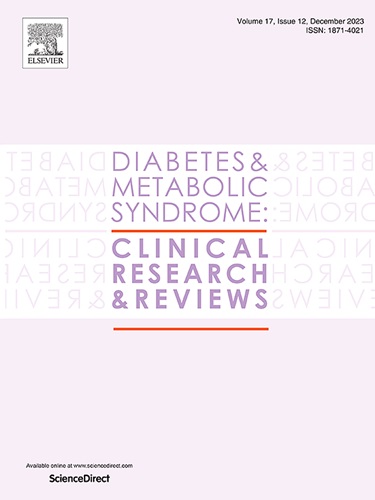Agreement and disagreement between diagnostic criteria for gestational diabetes and implications for clinical practice: A retrospective observational study
IF 3.4
Q1 ENDOCRINOLOGY & METABOLISM
Diabetes & Metabolic Syndrome-Clinical Research & Reviews
Pub Date : 2025-02-01
DOI:10.1016/j.dsx.2025.103207
引用次数: 0
Abstract
Aims
To evaluate agreement/disagreement between eleven gestational diabetes (GDM) diagnostic criteria, including five used in current clinical practice globally.
Methods
Records of 353 pregnant women with oral glucose tolerance test performed after 20 weeks of gestation were retrospectively reviewed. The diagnosis of GDM was compared using the IADPSG, DIPSI, WHO 1999, CDA 2003 and 2013, NICE 2015, JSOG 1984, ADIPS 1998, ADA 2004, NZSSD 2004 and EASD 1996 criteria. The agreement between criteria was expressed as Cohen's kappa coefficient (k; 0.4–0.6, moderate; 0.6–0.8, good; 0.8–1.0, very good) and disagreement as percentage (d). IADPSG criteria were used as a reference for comparison.
Results
The prevalence of GDM varied from 7.4 % (95 % CI, 4.9–10.4 %) by CDA 2003 criteria to 23.8 % (95 % CI, 19.5–28.4 %) by IADPSG criteria. Of the 55 pair-wise criteria comparisons, 29 (52.7 %) showed moderate, 16 (29.1 %) good, and 10 (18.2 %) very good agreement. Among the currently used criteria, the CDA 2013 (k = 0.811; d = 6.2 %) agreed the most, the DIPSI/WHO 1999 (k = 0.456) agreed the least, and the NICE 2015 (k = 0.580) criteria showed an intermediate agreement with the IADPSG criteria.
Conclusions
There is a marked variation in the prevalence of GDM, with a significant degree of disagreement between different diagnostic criteria. The study findings should be interpreted in the context of its retrospective nature and non-consecutive recruitment, which introduce a potential for selection bias.
妊娠期糖尿病诊断标准的一致和不一致及其对临床实践的影响:一项回顾性观察研究
目的评价11种妊娠糖尿病(GDM)诊断标准的一致性/差异性,包括目前全球临床实践中使用的5种诊断标准。方法回顾性分析353例妊娠20周后口服糖耐量试验的临床资料。采用IADPSG、DIPSI、WHO 1999、CDA 2003和2013、NICE 2015、JSOG 1984、ADIPS 1998、ADA 2004、NZSSD 2004和EASD 1996标准对GDM的诊断进行比较。标准间的一致性用Cohen’s kappa系数(k;0.4 - -0.6,温和;0.6 - -0.8,很好;0.8-1.0,非常好)和不一致百分比(d)。IADPSG标准作为比较参考。结果GDM的患病率从CDA 2003标准的7.4% (95% CI, 4.9 - 10.4%)到IADPSG标准的23.8% (95% CI, 19.5 - 28.4%)不等。在55个双标准比较中,29个(52.7%)显示中度一致,16个(29.1%)显示良好一致,10个(18.2%)显示非常良好一致。在目前使用的标准中,CDA 2013 (k = 0.811;d = 6.2%)与IADPSG标准的一致性最高,DIPSI/WHO 1999标准(k = 0.456)与IADPSG标准的一致性最低,而NICE 2015标准(k = 0.580)与IADPSG标准的一致性为中等。结论GDM患病率存在显著差异,不同诊断标准之间存在显著差异。研究结果应在其回顾性和非连续招募的背景下进行解释,这可能会导致选择偏差。
本文章由计算机程序翻译,如有差异,请以英文原文为准。
求助全文
约1分钟内获得全文
求助全文
来源期刊

Diabetes & Metabolic Syndrome-Clinical Research & Reviews
ENDOCRINOLOGY & METABOLISM-
CiteScore
22.90
自引率
2.00%
发文量
248
审稿时长
51 days
期刊介绍:
Diabetes and Metabolic Syndrome: Clinical Research and Reviews is the official journal of DiabetesIndia. It aims to provide a global platform for healthcare professionals, diabetes educators, and other stakeholders to submit their research on diabetes care.
Types of Publications:
Diabetes and Metabolic Syndrome: Clinical Research and Reviews publishes peer-reviewed original articles, reviews, short communications, case reports, letters to the Editor, and expert comments. Reviews and mini-reviews are particularly welcomed for areas within endocrinology undergoing rapid changes.
 求助内容:
求助内容: 应助结果提醒方式:
应助结果提醒方式:


